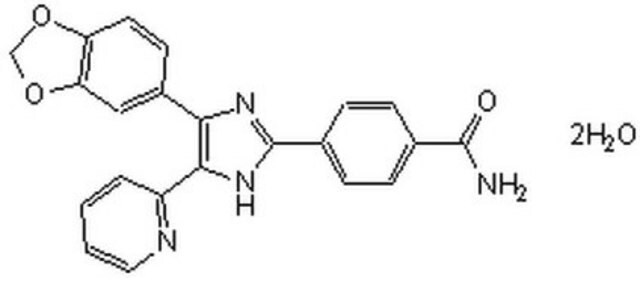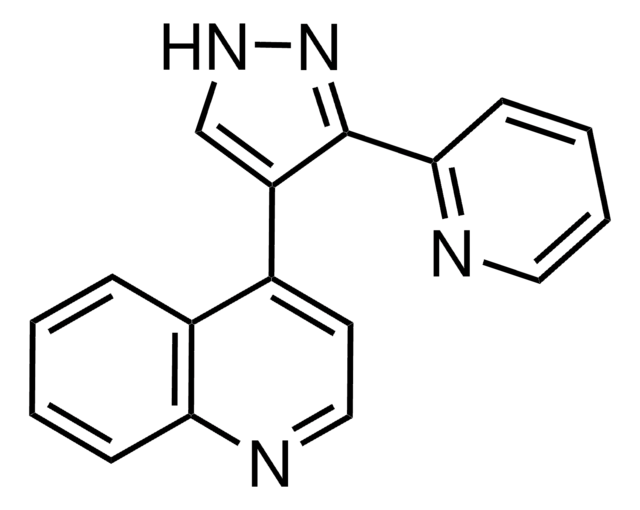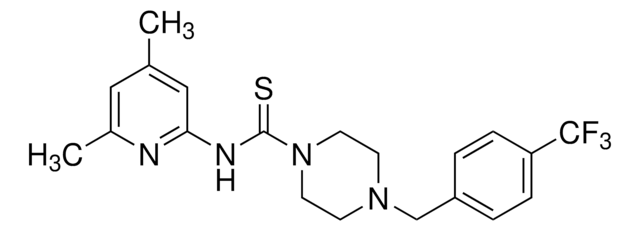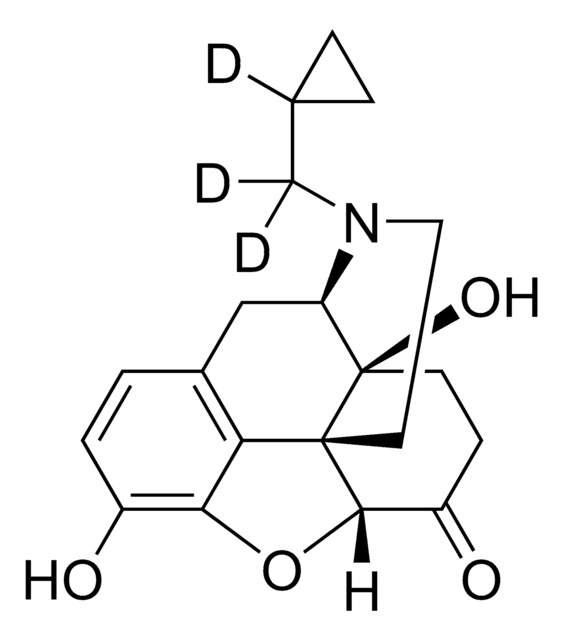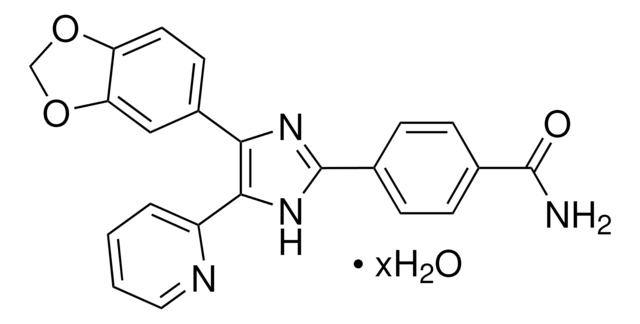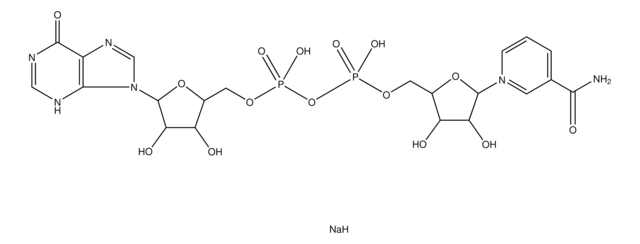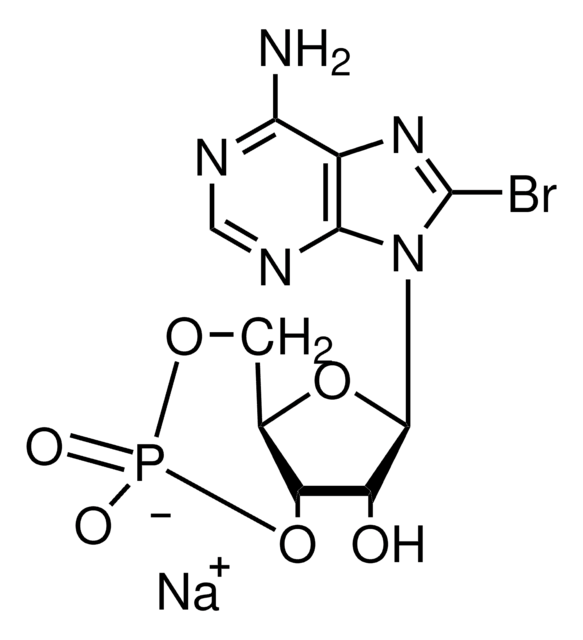S7071
SD-208
≥98% (HPLC), powder
Synonym(s):
2-(5-Chloro-2-fluorophenyl)pteridin-4-yl]pyridin-4-yl-amine
Sign Into View Organizational & Contract Pricing
All Photos(1)
About This Item
Empirical Formula (Hill Notation):
C17H10ClFN6
CAS Number:
Molecular Weight:
352.75
MDL number:
UNSPSC Code:
12352200
PubChem Substance ID:
NACRES:
NA.77
Recommended Products
Quality Level
Assay
≥98% (HPLC)
form
powder
color
off-white to tan
solubility
DMSO: >5 mg/mL
storage temp.
2-8°C
SMILES string
Fc1ccc(Cl)cc1-c2nc(Nc3ccncc3)c4nccnc4n2
InChI
1S/C17H10ClFN6/c18-10-1-2-13(19)12(9-10)15-24-16-14(21-7-8-22-16)17(25-15)23-11-3-5-20-6-4-11/h1-9H,(H,20,22,23,24,25)
InChI key
BERLXWPRSBJFHO-UHFFFAOYSA-N
Application
SD-208 was used to inhibit the activity of ALK5 kinase in bovine retinal vascular cells.2
Biochem/physiol Actions
SD-208 is TGF-βR I kinase inhibitor with IC50 =49 nM based on direct enzymatic assay of TGFRI kinase (ALK5) activity with a specificity of >100-fold against TGFRII and at least 17-fold over members of a panel of related protein kinases including p38a, p38b, p38d, JNK1, EGFR, MAPKAPK2, MKK6, ERK2, PKC, PKA, PKD, CDC2, and CaMKII.
SD-208 is a novel transforming growth factor beta receptor I (TGF-βR I) kinase inhibitor. SD-208 inhibits growth and invasiveness and enhances immunogenicity of murine and human glioma cells in vitro and in vivo.
SD-208 is an inhibitor of TGF β receptor 1 kinase that is reportedly effective against human malignant gliomas. It increases the lytic activity and tumor infiltration by polyclonal natural killer cells, CD8 T cells and macrophages.1
Signal Word
Warning
Hazard Statements
Precautionary Statements
Hazard Classifications
Acute Tox. 4 Oral
Storage Class Code
11 - Combustible Solids
WGK
WGK 3
Flash Point(F)
Not applicable
Flash Point(C)
Not applicable
Personal Protective Equipment
dust mask type N95 (US), Eyeshields, Gloves
Choose from one of the most recent versions:
Already Own This Product?
Find documentation for the products that you have recently purchased in the Document Library.
Katharina Seystahl et al.
Neuro-oncology, 17(2), 254-265 (2014-08-29)
The transforming growth factor (TGF)-β and vascular endothelial growth factor (VEGF) pathways have a major role in the pathogenesis of glioblastoma, notably immunosuppression, migration, and angiogenesis, but their interactions have remained poorly understood. We characterized TGF-β pathway activity in 9
Tanja Stüber et al.
Journal for immunotherapy of cancer, 8(1) (2020-04-19)
Immunotherapy with chimeric antigen receptor (CAR)-engineered T-cells is effective in some hematologic tumors. In solid tumors, however, sustained antitumor responses after CAR T-cell therapy remain to be demonstrated both in the pre-clinical and clinical setting. A perceived barrier to the
Martin Uhl et al.
Cancer research, 64(21), 7954-7961 (2004-11-03)
The cytokine transforming growth factor (TGF)-beta, by virtue of its immunosuppressive and promigratory properties, has become a major target for the experimental treatment of human malignant gliomas. Here we characterize the effects of a novel TGF-beta receptor (TGF-betaR) I kinase
Chandan K Nagaraju et al.
Scientific reports, 9(1), 8879-8879 (2019-06-22)
After myocardial infarction, resident fibroblasts (Fb) differentiate towards myofibroblasts (MyoFb), generating the scar tissue and the interstitial fibrosis seen in the adjacent myocardium. Fb and MyoFb have the potential to interact with cardiac myocytes (CMs) but insight into the phenotype-specific
Elisa Ventura et al.
Journal of immunology (Baltimore, Md. : 1950), 198(12), 4569-4574 (2017-05-10)
Glioblastoma is the most common and aggressive intrinsic brain tumor in adults. Self-renewing, highly tumorigenic glioma-initiating cells (GIC) have been linked to glioma invasive properties, immunomodulation, and increased angiogenesis, leading to resistance to therapy. TGF-β signaling has been associated with
Our team of scientists has experience in all areas of research including Life Science, Material Science, Chemical Synthesis, Chromatography, Analytical and many others.
Contact Technical Service
